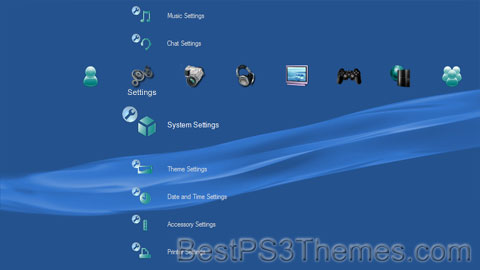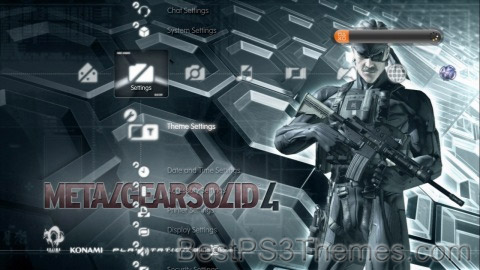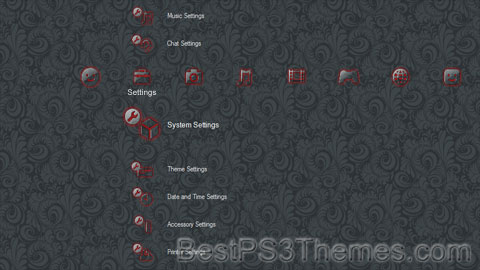NeoGAF theme by m0dus
Download: neogaf.p3t

(1 background)
 | |
Type of site | Internet forum |
|---|---|
| Available in | English |
| Owner | NeoGaf LLC (100% — Tyler Malka) |
| Created by | Jim Cordeira |
| URL | neogaf.com |
| Commercial | Yes |
| Registration | Optional[α] |
| Launched | 1999 (as Gaming-Age Forums) |
| Current status | Active |
| Written in | PHP, MySQL (powered by XenForo 2.2) |
NeoGAF is an Internet forum primarily dedicated to the discussion of video games. Founded as an adjunct to a video game news site under the name Gaming-Age Forums, on April 4, 2006 it changed its name to NeoGAF and became independently hosted and administered.
In 2017, site owner Tyler "Evilore" Malka was accused of sexual harassment. The allegations resulted in moderator resignations, mass exodus off the site and later site policy changes. Former members and moderators would later launch the new forum ResetEra.
History[edit]
NeoGAF began as "The Gaming-Age Forums", a forum for gaming website Gaming-Age. As Gaming-Age outgrew its hosting, IGN took over hosting of Gaming-Age's forums. After IGN ceased hosting of GAF in mid-2001, GAF moved to ezboard, and the administration of GAF became more estranged from Gaming Age.[1]
As the Gaming-Age staff became gradually more divorced from the day-to-day operation of GAF, problems with the new Gamesquad hosting cropped up. As software bugs in vBulletin 2, the version GAF was using at the time, continued to worsen, the Gamesquad hosting became increasingly more impractical, until the forums' database became corrupted, forcing a move to new hosting in order to change software and salvage what was left of the forums' database. In the spring of 2004, a fundraiser was held to move GAF to new hosting. On June 6, 2004, GAF took its newest form (known as NeoGAF to long-time posters) and moved to new hosting and new software, vBulletin 3.
On April 4, 2006, the forums were relaunched as NeoGAF, the former in-moniker, by its administrators. NeoGAF also features its own front page, an upfront admission that the forum's audience had drifted from that of its birthing news site, but yet mandated a single portal to represent the forum's members.
In an interview with VG247 in 2013, Tyler Malka claimed that he was offered $5 million to sell the website, turning down the offer.[2] One year later he stated in a forum post that the offer doubled, later saying he also turned down the deal.[3]
Sexual misconduct allegations against Malka and moderators exodus[edit]
On October 21, 2017, film director Ima Leupp described in a Facebook post, as part of the #MeToo phenomenon, a trip she took with NeoGAF owner Tyler "Evilore" Malka two years before. She said that while she and Malka were drinking together in a New Orleans hotel room in April 2015, she became very sick. While cleaning up in the shower, she said he approached her "fully naked" from behind without her consent.[4][5][6][7][8]
Following the sexual harassment scandal, half of the site's moderation staff resigned, and many users posted "suicide threads" wherein they demanded to be banned from the forum. The website went offline soon after.[9][10] Afterwards, NeoGAF was restored, suspending the off-topic sections of the board, and announcing that politics would henceforth be a prohibited subject of discussion and that moderation would become anonymous.[11]
Reception[edit]
Industry response[edit]
Members of the video games industry have been known to be members of the website, such as David Jaffe and Cliff Bleszinski.[12]
In 2007, in a thread discussing the resignation of Peter Moore from Microsoft, one user making fun of Microsoft's vice president of global marketing Jeff Bell received a personal message asking them "And your contribution to society is ... what?" The account was later found to be Jeff Bell's.[13] Malka later said he saw a shift on the forums with people in the games industry being more careful of what they post.[14]
In a 2009 thread post on NeoGAF dedicated to the game Scribblenauts, user "Feep" relayed the experience of discovering during E3 that he was able to go back in time with a time machine to collect a dinosaur in order to defeat an army of robot zombies that could not be defeated with regular weapons.[15][16][17] The story, memorialized as "Post 217", led to the games artist Edison Yan creating a desktop wallpaper image of the story, in appreciation of the positive fan response to the game, and the terms "Post Two One Seven", "Feep", and "Neogaf" were included as summonable objects in the game.[18] Scribblenauts' director Jeremiah Slaczka credited the word-of-mouth popularity of "Post 217" for part of the game's success at E3, and noted that he had contacted Feep to gain his permission to include "Feep" (appearing as a robot zombie) within the game.[19]
Describing the development struggles of 2017's Rime, Tequila Works co-founder Raúl Rubio Munárriz said that reading the forum's reactions reduced him to tears for two days and that if he had read them early on in development, the game would have been cancelled. "Partly because I just don't understand the cruelty, but more importantly because I could see those years over those two days, and I began to understand that maybe people can love something so much that they can hate it."[20]
Criticism[edit]
One of the biggest critics of NeoGAF was game designer and former Silicon Knights president Denis Dyack. In June 2008, he issued a challenge to forum users. He asked users to say whether they were for or against the then upcoming Silicon Knights game Too Human. Once the game was released, if the game received negative reception, Dyack would have "Owned by GAF" under his forum name. If positive reception, users who voted against the game would have had "Owned by Too Human."[21] Dyack would later go on the 1UP Yours podcast, explaining his challenge was an experiment to expose the lack of accountability on online forums, adding that NeoGAF would crumble if it doesn't reform itself.[22] He was later permanently banned from the site in August that same year after calling it the worst online forum.[23][24]
Circa 2017, NeoGAF was criticized for biased moderation and banning political dissidents. Tyler "Evilore" Malka made a post admitting biased moderation by at least one former member of the moderation staff. Malka stated that the ex-moderator banned hundreds of members without justification. Malka also made the declaration that discussion should be encouraged with different points of view, saying that people on the website have been "driven out, character assassinated, labeled traitor for not sounding angry enough, or for not being entirely on board with ostracizing someone else for the same reasons."[25]
In the media[edit]
In 2007, the website partnered up with The Get-Well Gamers Foundation to launch a donation campaign to bring video games to children in hospitals. NeoGAF raised $5,600 in cash and inventory donations over the October to December period.[26]
An exchange on the forum inspired members to start the development of Dudebro II in 2010. The game was intended to be a satirical take on the machismo found in some modern titles and was planned to feature Jon St. John, the voice of Duke Nukem, as the lead.[27] The team's last statement, in late 2017, disassociated the game from NeoGAF due to the sexual harassment controversy, claiming a new and unrelated team would be created to continue development.[28]
In June 2015, a Reddit sub-community devoted towards mocking NeoGAF became one of five communities shut down by the site.[29][30] Reddit argued the ban hit groups "that allow their communities to use the subreddit as a platform to harass individuals when moderators don’t take action."[31]
Vice News noted the site was one of the largest drivers of traffic to Hillary Clinton's website during the 2016 U.S. presidential election.[32]
ResetEra[edit]
Several former NeoGAF members established ResetEra on October 24, 2017, after NeoGAF's owner, Tyler Malka faced sexual misconduct accusations.[33][34]
From November 2017 to March 2018, ResetEra hosted Q&A sessions with Insomniac Games, Chucklefish, LizardCube, DotEmu, and Tom Happ and Dan Adelman, the creators of Axiom Verge.[35]
ResetEra moderators enacted the site's first game ban by barring all promotion of the game Hogwarts Legacy, citing a "far-right" YouTube channel run by then-lead designer Troy Leavitt, and comments criticized for transphobia made by author J. K. Rowling.[36] In January 2023, the ban was extended to include any discussion of the game.[37][38]
In October 2021, ResetEra was purchased for 4.5 million dollars by MOBA Network,[39] a Swedish company that focuses on managing web-based forums for video games and esports. In a statement, MOBA Network claimed that it wants to "increase advertising revenue through a higher share of direct sales, implementation of new ad formats, and a long-term product development strategy."[40]
ResetEra is cited for hat tips by PCGamesN and other publications.[41] Game developers and journalists have visited the forums, including journalist Geoff Keighley; Cory Barlog, Creative Director at Santa Monica Studio; James Stevenson, the Community Director for Insomniac Games; and Thomas Mahler, director of Moon Studios; among others.[42][43][44]
See also[edit]
Notes[edit]
- ^ Registration requires admin approval and is required for creating threads and posting messages.
References[edit]
- ^ Oxford, Nadia (April 8, 2010). "The Story of NeoGAF". GamePro. IDG. p. 1. Archived from the original on March 3, 2016.
- ^ Donaldson, Alex (May 17, 2013). "The story of NeoGAF part three: money, money, money". VG247. Gamer Network. Archived from the original on October 23, 2017. Retrieved June 5, 2017.
- ^ Cook, Dave (May 22, 2014). "NeoGAF's owner turned down $10 million offer for the site". VG247. Gamer Network. Archived from the original on December 8, 2017. Retrieved June 5, 2017.
- ^ Klepek, Patrick (October 23, 2017). "Inside the Sexual Misconduct Allegations Rocking NeoGAF's Last 48 Hours". Vice. Archived from the original on July 9, 2020. Retrieved July 7, 2020.
- ^ D'Anastasio, Cecilia (October 22, 2017). "NeoGAF Goes Dark After Sexual Misconduct Allegation Against Owner". Kotaku. Archived from the original on June 18, 2020. Retrieved July 7, 2020.
- ^ Robertson, Adi (October 23, 2017). "Games forum NeoGAF in chaos after owner accused of sexual misconduct". The Verge. Archived from the original on October 28, 2017. Retrieved July 7, 2020.
- ^ Good, Owen (October 22, 2017). "NeoGAF goes silent following allegations against owner". Polygon. Archived from the original on July 8, 2020. Retrieved July 7, 2020.
- ^ Philips, Tom (October 23, 2017). "NeoGAF offline after owner accused of sexual misconduct". Eurogamer. Archived from the original on July 7, 2020. Retrieved July 7, 2020.
- ^ Cade Onder (October 22, 2017). "Gaming forum NeoGAF goes up in smoke after sexual harassment allegations against founder". GameZone. Archived from the original on October 22, 2017. Retrieved October 22, 2017.
- ^ Crecente, Brian (October 22, 2017). "Video Game Forum NeoGAF Offline Amid Sexual Assault Allegations Against Owner". Glixel. Rolling Stone. Archived from the original on October 22, 2017. Retrieved October 22, 2017.
- ^ EviLore (October 24, 2017). "The state of NeoGAF". NeoGaf. Archived from the original on November 3, 2017. Retrieved November 24, 2019.
- ^ Donaldson, Alex (May 15, 2013). "The story of NeoGAF part one: humble beginnings". VG247. Gamer Network. Archived from the original on August 7, 2017. Retrieved June 5, 2017.
- ^ Rea, Jared (July 18, 2007). "Jeff Bell asks message board user: "And your contribution to society is ... what?"". Joystiq. AOL. Archived from the original on December 21, 2007.
- ^ Donaldson, Alex (May 16, 2013). "The story of NeoGAF part two: scandal and control". VG247. Gamer Network. Archived from the original on August 3, 2017. Retrieved August 2, 2017.
- ^ McElroy, Griffon (June 5, 2009). "Hands-on: Scribblenauts". Joystiq. AOL. Archived from the original on January 27, 2013. Retrieved June 12, 2009.
- ^ Ashley, Robert (June 11, 2009). "Scribblenauts: How a Nobody Game Became the Talk of This Year's E3". Crispy Gamer. Archived from the original on July 22, 2014. Retrieved June 11, 2009.
- ^ Harold, Charles (June 8, 2009). "A game to help you think creatively". USA Today. Archived from the original on November 9, 2012. Retrieved November 6, 2009.
- ^ Fletcher, JC (June 15, 2009). "Celebrate a legendary Scribblenauts moment with this wallpaper". Joystiq. AOL. Archived from the original on July 14, 2012. Retrieved June 15, 2009.
- ^ Broder, Aaron (September 8, 2009). "Q&A: Scribblenauts emerges as breakthrough game for 5th Cell". Tech Flash. Archived from the original on March 22, 2014. Retrieved September 13, 2009.
- ^ Maxwell, Ben (May 2017). "The Year's Essential Adventure is Finally Here". Edge. United Kingdom: Future plc. Archived from the original on September 1, 2019. Retrieved July 11, 2017.
- ^ Bennett, Colette (June 25, 2008). "Denis Dyack makes bet with NeoGAF forum users about Too Human". Destructoid. Archived from the original on September 6, 2015. Retrieved June 7, 2017.
- ^ Kollar, Philip (July 3, 2008). "Dyack on 1UP Yours: Forums Need Reform". 1UP Yours. 1UP.com. Archived from the original on June 30, 2012. Retrieved June 7, 2017.
- ^ bleahy (August 19, 2008). "NeoGAF Bans 'Too Human' Creator, Denis Dyack". G4tv.com. Archived from the original on February 18, 2015. Retrieved February 16, 2015.
- ^ Garratt, Patrick (August 20, 2008). "Dyack: I posted on NeoGAF because it's "the worst forum"". VG247. Gamer Network. Archived from the original on August 26, 2017. Retrieved June 5, 2017.
- ^ Leack, Jonathan (June 5, 2017). "NeoGAF Owner Confirms Previously Biased Moderation, Pushes for Greater Diversity of Opinions". Game Revolution. CraveOnline. Archived from the original on June 5, 2017. Retrieved June 5, 2017.
Spiderman Black
Spiderman Black theme by mikeyrawr
Download: SpidermanBlack.p3t
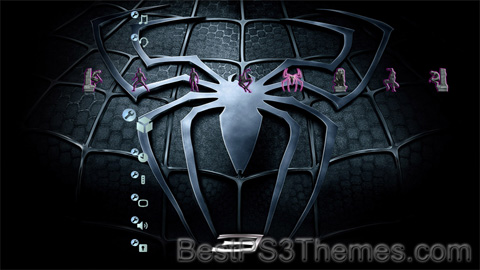
(1 background)
P3T Unpacker v0.12
Copyright (c) 2007. Anoop MenonThis program unpacks Playstation 3 Theme files (.p3t) so that you can touch-up an existing theme to your likings or use a certain wallpaper from it (as many themes have multiple). But remember, if you use content from another theme and release it, be sure to give credit!
Download for Windows: p3textractor.zip
Instructions:
Download p3textractor.zip from above. Extract the files to a folder with a program such as WinZip or WinRAR. Now there are multiple ways to extract the theme.
The first way is to simply open the p3t file with p3textractor.exe. If you don’t know how to do this, right click the p3t file and select Open With. Alternatively, open the p3t file and it will ask you to select a program to open with. Click Browse and find p3textractor.exe from where you previously extracted it to. It will open CMD and extract the theme to extracted.[filename]. After that, all you need to do for any future p3t files is open them and it will extract.
The second way is very simple. Just drag the p3t file to p3textractor.exe. It will open CMD and extract the theme to extracted.[filename].
For the third way, first put the p3t file you want to extract into the same folder as p3textractor.exe. Open CMD and browse to the folder with p3extractor.exe. Enter the following:
p3textractor filename.p3t [destination path]Replace filename with the name of the p3t file, and replace [destination path] with the name of the folder you want the files to be extracted to. A destination path is not required. By default it will extract to extracted.filename.Project Mayhem
iPhone/Mac
iPhone/Mac theme by Darkjaksrevenge
Download: Iphone.p3t

(1 background)
P3T Unpacker v0.12
Copyright (c) 2007. Anoop MenonThis program unpacks Playstation 3 Theme files (.p3t) so that you can touch-up an existing theme to your likings or use a certain wallpaper from it (as many themes have multiple). But remember, if you use content from another theme and release it, be sure to give credit!
Download for Windows: p3textractor.zip
Instructions:
Download p3textractor.zip from above. Extract the files to a folder with a program such as WinZip or WinRAR. Now there are multiple ways to extract the theme.
The first way is to simply open the p3t file with p3textractor.exe. If you don’t know how to do this, right click the p3t file and select Open With. Alternatively, open the p3t file and it will ask you to select a program to open with. Click Browse and find p3textractor.exe from where you previously extracted it to. It will open CMD and extract the theme to extracted.[filename]. After that, all you need to do for any future p3t files is open them and it will extract.
The second way is very simple. Just drag the p3t file to p3textractor.exe. It will open CMD and extract the theme to extracted.[filename].
For the third way, first put the p3t file you want to extract into the same folder as p3textractor.exe. Open CMD and browse to the folder with p3extractor.exe. Enter the following:
p3textractor filename.p3t [destination path]Replace filename with the name of the p3t file, and replace [destination path] with the name of the folder you want the files to be extracted to. A destination path is not required. By default it will extract to extracted.filename.Blasto
Star Wars Troopers
Star Wars Troopers theme by olapbill
Download: StarWarsTroopers.p3t
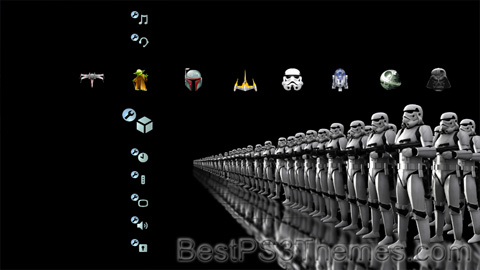
(2 backgrounds)
P3T Unpacker v0.12
Copyright (c) 2007. Anoop MenonThis program unpacks Playstation 3 Theme files (.p3t) so that you can touch-up an existing theme to your likings or use a certain wallpaper from it (as many themes have multiple). But remember, if you use content from another theme and release it, be sure to give credit!
Download for Windows: p3textractor.zip
Instructions:
Download p3textractor.zip from above. Extract the files to a folder with a program such as WinZip or WinRAR. Now there are multiple ways to extract the theme.
The first way is to simply open the p3t file with p3textractor.exe. If you don’t know how to do this, right click the p3t file and select Open With. Alternatively, open the p3t file and it will ask you to select a program to open with. Click Browse and find p3textractor.exe from where you previously extracted it to. It will open CMD and extract the theme to extracted.[filename]. After that, all you need to do for any future p3t files is open them and it will extract.
The second way is very simple. Just drag the p3t file to p3textractor.exe. It will open CMD and extract the theme to extracted.[filename].
For the third way, first put the p3t file you want to extract into the same folder as p3textractor.exe. Open CMD and browse to the folder with p3extractor.exe. Enter the following:
p3textractor filename.p3t [destination path]Replace filename with the name of the p3t file, and replace [destination path] with the name of the folder you want the files to be extracted to. A destination path is not required. By default it will extract to extracted.filename.Metal Gear Solid 4
The Simpsons #2
The Simpsons theme by borrer0
Download: TheSimpsons_2.p3t
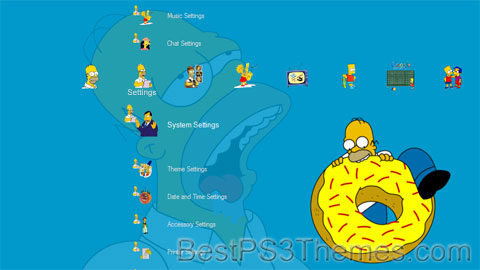
(13 backgrounds)
The Simpsons 
Genre Created by Matt Groening Based on The Simpsons shorts
by Matt GroeningDeveloped by - James L. Brooks
- Matt Groening
- Sam Simon
Showrunners - James L. Brooks (seasons 1–2)
- Matt Groening (seasons 1–2)
- Sam Simon (seasons 1–2)
- Al Jean (seasons 3–4; 13—32)
- Mike Reiss (seasons 3–4)
- David Mirkin (seasons 5–6)
- Bill Oakley (seasons 7–8)
- Josh Weinstein (seasons 7–8)
- Mike Scully (seasons 9–12)
- Matt Selman (season 33–present)
Voices of Theme music composer Danny Elfman Opening theme "The Simpsons Theme" Ending theme "The Simpsons Theme" (reprise) Composers Richard Gibbs (1989–1990)
Alf Clausen (1990–2017)
Bleeding Fingers Music (2017–present)Country of origin United States Original language English No. of seasons 35 No. of episodes 768 (list of episodes) Production Executive producers List- James L. Brooks
- Matt Groening
- Al Jean (1992–1993; 1995–present)
- Matt Selman (2005–present)
- John Frink (2009–present)
- Sam Simon (1989–1993)
- Mike Reiss (1992–1993; 1995–1998)
- David Mirkin (1993–1995)
- Bill Oakley (1995–1997)
- Josh Weinstein (1995–1997)
- Mike Scully (1997–2001)
- David X. Cohen (1998–1999)
- George Meyer (1999–2001)
- Carolyn Omine (2005–2006)
- Tim Long (2005–2009)
- Ian Maxtone-Graham (2005–2012)
Producers - Bonita Pietila
- Richard Raynis
- Richard Sakai
- Denise Sirkot
Editors - Don Barrozo
- Michael Bridge
Running time 21–24 minutes Production companies - Gracie Films
- 20th Television[a] (seasons 1–32)
- 20th Television Animation (season 33–present)[b]
Original release Network Fox Release December 17, 1989 –
presentThe Simpsons is an American animated sitcom created by Matt Groening for the Fox Broadcasting Company.[1][2][3] Developed by Groening, James L. Brooks, and Sam Simon, the series is a satirical depiction of American life, epitomized by the Simpson family, which consists of Homer, Marge, Bart, Lisa, and Maggie. Set in the fictional town of Springfield, it caricatures society, Western culture, television, and the human condition.
The family was conceived by Groening shortly before a solicitation for a series of animated shorts with producer Brooks. He created a dysfunctional family and named the characters after his own family members, substituting Bart for his own name; he thought Simpson was a funny name in that it sounded similar to "simpleton".[4] The shorts became a part of The Tracey Ullman Show on April 19, 1987. After three seasons, the sketch was developed into a half-hour prime time show and became Fox's first series to land in the Top 30 ratings in a season (1989–1990).
Since its debut on December 17, 1989, 768 episodes of the show have been broadcast. It is the longest-running American animated series, longest-running American sitcom, and the longest-running American scripted primetime television series, both in seasons and individual episodes. A feature-length film, The Simpsons Movie, was released in theaters worldwide on July 27, 2007, to critical and commercial success, with a sequel in development as of 2018. The series has also spawned numerous comic book series, video games, books, and other related media, as well as a billion-dollar merchandising industry. The Simpsons is a joint production by Gracie Films and 20th Television.[5]
On January 26, 2023, the series was renewed for its 35th and 36th seasons, taking the show through the 2024–25 television season.[6] Both seasons contain a combined total of 51 episodes. Seven of these episodes are season 34 holdovers, while the other 44 will be produced in the production cycle of the upcoming seasons, bringing the show's overall episode total up to 801.[7] Season 35 premiered on October 1, 2023.[8]
The Simpsons received widespread acclaim throughout its early seasons in the 1990s, which are generally considered its "golden age". Since then, it has been criticized for a perceived decline in quality. Time named it the 20th century's best television series,[9] and Erik Adams of The A.V. Club named it "television's crowning achievement regardless of format".[10] On January 14, 2000, the Simpson family was awarded a star on the Hollywood Walk of Fame. It has won dozens of awards since it debuted as a series, including 37 Primetime Emmy Awards, 34 Annie Awards, and 2 Peabody Awards. Homer's exclamatory catchphrase of "D'oh!" has been adopted into the English language, while The Simpsons has influenced many other later adult-oriented animated sitcom television series.
Premise[edit]
Characters[edit]
The main characters are the Simpson family, who live in the fictional "Middle America" town of Springfield.[11] Homer, the father, works as a safety inspector at the Springfield Nuclear Power Plant, a position at odds with his careless, buffoonish personality. He is married to Marge (née Bouvier), a stereotypical American housewife and mother. They have three children: Bart, a ten-year-old troublemaker and prankster; Lisa, a precocious eight-year-old activist; and Maggie, the baby of the family who rarely speaks, but communicates by sucking on a pacifier. Although the family is dysfunctional, many episodes examine their relationships and bonds with each other and they are often shown to care about one another.[12]
The family also owns a greyhound, Santa's Little Helper, (who first appeared in the episode "Simpsons Roasting on an Open Fire" and a cat, Snowball II, who is replaced by a cat also called Snowball II in the fifteenth-season episode "I, (Annoyed Grunt)-Bot".[13] Extended members of the Simpson and Bouvier family in the main cast include Homer's father Abe and Marge's sisters Patty and Selma. Marge's mother Jacqueline and Homer's mother Mona appear less frequently.

The Simpsons sports a vast array of secondary and tertiary characters. The show includes a vast array of quirky supporting characters, which include Homer's friends Barney Gumble, Lenny Leonard and Carl Carlson; the school principal Seymour Skinner and staff members such as Edna Krabappel and Groundskeeper Willie; students such as Milhouse Van Houten, Nelson Muntz and Ralph Wiggum; shopkeepers such as Apu Nahasapeemapetilon, Comic Book Guy and Moe Szyslak; government figures Mayor "Diamond" Joe Quimby and Clancy Wiggum; next-door neighbor Ned Flanders; local celebrities such as Krusty the Clown and news reporter Kent Brockman; nuclear tycoon Montgomery Burns and his devoted assistant Waylon Smithers; and dozens more.
The creators originally intended many of these characters as one-time jokes or for fulfilling needed functions in the town. A number of them have gained expanded roles and subsequently starred in their own episodes. According to Matt Groening, the show adopted the concept of a large supporting cast from the comedy show SCTV.[14]
Continuity and the floating timeline[edit]
Despite the depiction of yearly milestones such as holidays or birthdays passing, the characters never age. The series uses a floating timeline in which episodes generally take place in the year the episode is produced. Flashbacks and flashforwards do occasionally depict the characters at other points in their lives, with the timeline of these depictions also generally floating relative to the year the episode is produced. For example, the 1991 episodes "The Way We Was" and "I Married Marge" depict Homer and Marge as high schoolers in the 1970s who had Bart (who is always 10 years old) in the early '80s, while the 2008 episode "That '90s Show" depicts Homer and Marge as a childless couple in the '90s, and the 2021 episode "Do Pizza Bots Dream of Electric Guitars" portrays Homer as an adolescent in the same period. The 1995 episode "Lisa's Wedding" takes place during Lisa's college years in the then-future year of 2010, the same year the show began airing its 22nd season, in which Lisa was still 8. Regarding the contradictory flashbacks, Selman stated that "they all kind of happened in their imaginary world."[15]
The show follows a loose and inconsistent continuity. For example, Krusty the Clown may be able to read in one episode, but not in another. However, it is consistently portrayed that he is Jewish, that his father was a rabbi, and that his career began in the 1960s. The latter point introduces another snag in the floating timeline: historical periods that are a core part of a character's backstory remain so even when their age makes it unlikely or impossible, such as Grampa Simpson and Principal Skinner's respective service in World War II and Vietnam.
The only episodes not part of the series' main canon are the Treehouse of Horror episodes, which often feature the deaths of main characters. Characters who die in "regular" episodes, such as Maude Flanders, Mona Simpson and Edna Krabappel, however, stay dead. Most episodes end with the status quo being restored, though occasionally major changes will stick, such as Lisa's conversions to vegetarianism and Buddhism, the divorce of Milhouse van Houten's parents, and the marriage and subsequent parenthood of Apu and Manjula.
Setting[edit]
The Simpsons takes place in a fictional American town called Springfield. Although there are many real settlements in America named Springfield,[16] the town the show is set in is fictional. The state it is in is not established. In fact, the show is intentionally evasive with regard to Springfield's location.[17] Springfield's geography and that of its surroundings is inconsistent: from one episode to another, it may have coastlines, deserts, vast farmland, mountains, or whatever the story or joke requires.[18] Groening has said that Springfield has much in common with Portland, Oregon, the city where he grew up.[19] Groening has said that he named it after Springfield, Oregon, and the fictitious Springfield which was the setting of the series Father Knows Best. He "figured out that Springfield was one of the most common names for a city in the U.S. In anticipation of the success of the show, I thought, 'This will be cool; everyone will think it's their Springfield.' And they do."[20] Many landmarks, including street names, have connections to Portland.[21]
Production[edit]
Development[edit]
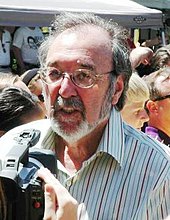
James L. Brooks (pictured) asked Matt Groening to create a series of animated shorts for The Tracey Ullman Show. When producer James L. Brooks was working on the television variety show The Tracey Ullman Show, he decided to include small animated sketches before and after the commercial breaks. Having seen one of cartoonist Matt Groening's Life in Hell comic strips, Brooks asked Groening to pitch an idea for a series of animated shorts. Groening initially intended to present an animated version of his Life in Hell series.[22] However, Groening later realized that animating Life in Hell would require the rescinding of publication rights for his life's work. He therefore chose another approach while waiting in the lobby of Brooks's office for the pitch meeting, hurriedly formulating his version of a dysfunctional family that became the Simpsons.[22][23] He named the characters after his own family members, substituting "Bart" for his own name, adopting an anagram of the word brat.[22]
The Simpson family first appeared as shorts in The Tracey Ullman Show on April 19, 1987.[24] Groening submitted only basic sketches to the animators and assumed that the figures would be cleaned up in production. However, the animators merely re-traced his drawings, which led to the crude appearance of the characters in the initial shorts.[22] The animation was produced domestically at Klasky Csupo,[25][26] with Wes Archer, David Silverman, and Bill Kopp being animators for the first season.[27] The colorist, "Georgie" Gyorgyi Kovacs Peluce (Kovács Györgyike)[28][29][30][31][32][33] made the characters yellow; as Bart, Lisa and Maggie have no hairlines, she felt they would look strange if they were flesh-colored. Groening supported the decision, saying: "Marge is yellow with blue hair? That's hilarious — let's do it!"[27]
In 1989, a team of production companies adapted The Simpsons into a half-hour series for the Fox Broadcasting Company. The team included the Klasky Csupo animation house. Brooks negotiated a provision in the contract with the Fox network that prevented Fox from interfering with the show's content.[34] Groening said his goal in creating the show was to offer the audience an alternative to what he called "the mainstream trash" that they were watching.[35] The half-hour series premiered on December 17, 1989, with "Simpsons Roasting on an Open Fire".[36] "Some Enchanted Evening" was the first full-length episode produced, but it did not broadcast until May 1990, as the last episode of the first season, because of animation problems.[37] In 1992, Tracey Ullman filed a lawsuit against Fox, claiming that her show was the source of the series' success. The suit said she should receive a share of the profits of The Simpsons[38]—a claim rejected by the courts.[39]
Executive producers and showrunners[edit]

Matt Groening, the creator of The Simpsons List of showrunners throughout the series' run:
- Season 1–2: Matt Groening, James L. Brooks, & Sam Simon
- Season 3–4: Al Jean & Mike Reiss
- Season 5–6: David Mirkin
- Season 7–8: Bill Oakley & Josh Weinstein
- Season 9–12: Mike Scully
- Season 13–31: Al Jean
- Season 32–present: Al Jean & Matt Selman
Matt Groening and James L. Brooks have served as executive producers during the show's entire history, and also function as creative consultants. Sam Simon, described by former Simpsons director Brad Bird as "the unsung hero" of the show,[40] served as creative supervisor for the first four seasons. He was constantly at odds with Groening, Brooks and the show's production company Gracie Films and left in 1993.[41] Before leaving, he negotiated a deal that sees him receive a share of the profits every year, and an executive producer credit despite not having worked on the show since 1993,[41][42] at least until his passing in 2015.[43] A more involved position on the show is the showrunner, who acts as head writer and manages the show's production for an entire season.[27]
Writing[edit]
The first team of writers, assembled by Sam Simon, consisted of John Swartzwelder, Jon Vitti, George Meyer, Jeff Martin, Al Jean, Mike Reiss, Jay Kogen and Wallace Wolodarsky.[44] Newer Simpsons' writing teams typically consist of sixteen writers who propose episode ideas at the beginning of each December.[45] The main writer of each episode writes the first draft. Group rewriting sessions develop final scripts by adding or removing jokes, inserting scenes, and calling for re-readings of lines by the show's vocal performers.[46] Until 2004,[47] George Meyer, who had developed the show since the first season, was active in these sessions. According to long-time writer Jon Vitti, Meyer usually invented the best lines in a given episode, even though other writers may receive script credits.[46] Each episode takes six months to produce so the show rarely comments on current events.[48]
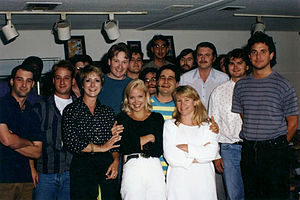
Part of the writing staff of The Simpsons in 1992. Back row, left to right: Mike Mendel, Colin A. B. V. Lewis (partial), Jeff Goldstein, Al Jean (partial), Conan O'Brien, Bill Oakley, Josh Weinstein, Mike Reiss, Ken Tsumura, George Meyer, John Swartzwelder, Jon Vitti (partial), CJ Gibson, and David M. Stern. Front row, left to right: Dee Capelli, Lona Williams, and unknown. Credited with sixty episodes, John Swartzwelder is the most prolific writer on The Simpsons.[49] One of the best-known former writers is Conan O'Brien, who contributed to several episodes in the early 1990s before replacing David Letterman as host of the talk show Late Night.[50] English comedian Ricky Gervais wrote the episode "Homer Simpson, This Is Your Wife", becoming the first celebrity both to write and guest star in the same episode.[51] Seth Rogen and Evan Goldberg, writers of the film Superbad, wrote the episode "Homer the Whopper", with Rogen voicing a character in it.[52]
At the end of 2007, the writers of The Simpsons went on strike together with the other members of the Writers Guild of America, East. The show's writers had joined the guild in 1998.[53]
In May 2023, the writers of The Simpsons went on strike together with the other members of the Writers Guild of America, East.[54][55]
Voice actors[edit]

